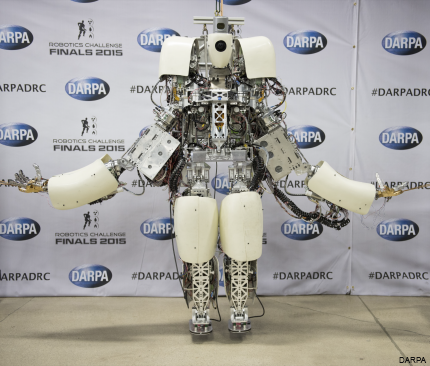DARPA's robotics rumble arrives
Twenty-five disaster-response robots, representing the state of the art in robotics technology, are ready to run a two-day gauntlet.

Team NEDO-Hydra’s Robot 1.
And then there will be one.
After a nearly three-year process that saw big jumps in the size of the field, the degree of difficulty and the prize money, the much-anticipated DARPA Robotics Challenge takes the stage June 5-6 at Fairplex in Pomona, Calif., where an international field of 25 teams and their robots will try to navigate an emergency response-style obstacle course.
Launched by the Defense Advanced Research Projects Agency in October 2012, the challenge, or DRC, has gone through a design phase, a virtual robotics challenge and “live” robotics trials, the latter in December 2013. Along the way, technological advances made by the teams prompted DARPA to make the challenge ever more difficult.
In the finals, the robots will have to operate completely wirelessly—without tethers or cords for operations, communications or power—and complete a series of tasks, including: driving, stopping and exiting a utility vehicle; opening and going through a door; finding and closing a valve; cutting through a wall; performing a “Surprise Task” that DARPA won’t tell them about ahead of time; clearing debris and walking through rough terrain; and walking up stairs to the finish.

A look at the DRC's challenging course.
To make things more interesting—and more like a real disaster site—DARPA will degrade those wireless communications, at times to the point where robots will have to function on their own, without input from a controller. And should a robot fall, it must pick itself back up or its competition is over.
The 25 teams hail from seven countries and feature a mix of industry, academic and government participants. The prize money: $2 million for first place, $1 million for second and $500,000 for third.
In addition to the competition, the event, which is open to the public, also will feature an expo with about 70 interactive displays where visitors can meet with technology developers and emergency responders.
If you can’t make it to Pomona to watch the competition, Engadget points out that the website live.curiositystream.com will stream the event from 10 a.m. to 7 p.m. on June 5 and from 11 a.m. to 9:30 p.m. on June 6.
The 25 teams taking part, listed by country, are:
Germany
Team Hector, Technical University of Darmstadt
Team NimbRo Rescue, University of Bonn
Hong Kong
Team HKU, University of Hong Kong
Italy
Team WALK-MAN Italian Institute of Technology, Genoa, and the University of Pisa
Japan
Team Aero, University of Tokyo
Team AIST-NEDO, National Institute of Advanced Industrial Science and Technology, Tokyo
Team HRP2-Tokyo, University of Tokyo
Team NEDO-Hydra, University of Tokyo, Chiba Institute of Technology, Osaka University, Kobe University
Team NEDO-JSK, University of Tokyo
People’s Republic of China
Team Intelligent Pioneer, Hefei Institutes of Physical Science, Chinese Academy of Sciences, Changzhou
South Korea
Team KAIST, Korea Advanced Institute of Science and Technology, Daejeon
Team ROBOTIS, ROBOTIS, Seoul
Team SNU, Seoul National University
United States
Tartan Rescue, Carnegie Mellon University, National Robotics Engineering Center, Pittsburgh
Team IHMC Robotics, Florida Institute for Human & Machine Cognition, Pensacola, Fla.
Team MIT, Massachusetts Institute of Technology, Cambridge, Mass.
Team RoboSimian, NASA Jet Propulsion Laboratory, Pasadena, Calif.
Team THOR, University of California, Los Angeles; University of Pennsylvania, Philadelphia
Team TRACLabs, TRACLabs, Inc., Webster, Texas
Team Trooper, Lockheed Martin Advanced Technology Laboratories, Cherry Hill, N.J., Rensselaer Polytechnic University, Troy, N.Y.; University of Pennsylvania, Philadelphia
Team Valor, Virginia Tech, Blacksburg, Va.
Team ViGIR, TORC Robotics, Blacksburg, Va.; Technische Universität Darmstadt, Germany; Virginia Tech, Blacksburg, Va.; Oregon State University, Corvallis, Ore.
Team WPI-CMU, Worcester Polytechnic Institute, Worcester, Mass.
Team DRC-Hubo @ UNLV, University of Nevada, Las Vegas




